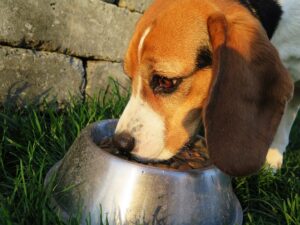 Traditionally, most pet owners fed their dogs pre-prepared food, either from a tin or in the form of dried kibbles. While these used to be the only options, over the years, the dog food market has expanded rapidly, and there are now loads of other brands and products available. However, talk has also turned to the quality of the food we feed to our pets, particularly after various dog food scandals. As a result, many devoted dog owners have considered making their own dog food.
Traditionally, most pet owners fed their dogs pre-prepared food, either from a tin or in the form of dried kibbles. While these used to be the only options, over the years, the dog food market has expanded rapidly, and there are now loads of other brands and products available. However, talk has also turned to the quality of the food we feed to our pets, particularly after various dog food scandals. As a result, many devoted dog owners have considered making their own dog food.
The process is surprisingly easy, and there are many groups online to help you find ways to build unique meal plans for your pup. Feeding your dog homemade food offers many benefits, including allowing you to know what’s in the food and providing your dog with a variety of different options to suit their varying moods. After all, you wouldn’t want to eat the same dry kibbles every day, so why should your dog?
There can also be cost savings for some dog owners, but generally speaking, making homemade dog food is not a cheap or easy endeavour. If you’re thinking about dipping your toes into the world of homemade dog food, here are some of the important facts you need to know.
Dogs Have Complex Nutritional Needs
Like humans, dogs need a variety of vitamins and minerals, which can be found in a range of different natural ingredients. So, you can’t just feed your dog leftovers from your own plate. Homemade dog food requires specially formulated recipes that provide the right balance of proteins, fats, carbohydrates, vitamins, and minerals dogs need. Veterinary nutritionists design these recipes to be complete and balanced for dogs. Working with a nutritionist will also ensure that your dog gets the right food, as every dog is different, and certain breeds might have unique requirements.
You Don’t Have To Start Entirely From Scratch
Making homemade meals for your dog might seem daunting at first, but it doesn’t have to be that way. By researching brands of raw dog food that use high-quality, natural ingredients, you start the transition slowly. Use these raw foods as a base, and supplement them with additional ingredients that your dog enjoys. As you become more confident about feeding your dog homemade food, you can make your own raw mince. Alternatively, you can continue using quality, pre-prepared raw food as a base for your dog’s meals but add in extras to give them everything they need. By not starting entirely from scratch, you can make sure your dog is getting all the nutrients they need while still being fully aware of what’s going into their meals.
Finding High-Quality, Fresh Ingredients Is Key
Since you’re handling your dog’s entire diet, use fresh, high-quality ingredients to ensure that you’re giving them meals that are good for them. Avoid processed meats, like hot dogs or ham, because while these might be cheap and tasty, they’re also high in salt and preservatives, making them unsuitable for your dog. Instead, choose lean, natural protein sources like chicken, turkey, eggs, and fish, as well as offal. Supplement with dog-safe fruits and veggies like cooked sweet potatoes, carrots, green beans, and seedless watermelon. Whole grains like brown rice can provide carbohydrates. By buying quality ingredients, you can give your dog tasty, healthy meals they’ll enjoy.
It’s Vital All Ingredients Are Dog Safe
Not everything that humans can eat is safe for dogs, so when you’re choosing additions for your dog’s diet, you need to make sure they are good for them. While everyone knows that chocolate is bad for dogs, there are many other natural ingredients, such as garlic, grapes, and macadamia nuts, which are also poisonous for dogs and can’t be part of their diet, even in small amounts. Thankfully, many human foods are safe for dogs to eat, including a lot of fresh vegetables and fruits. Many of these need to be given in limited quantities to ensure that your dog doesn’t ingest too much sugar or fat, so it’s vital that you create a balanced meal plan for your pup.
A Final Word
Ultimately, preparing homemade meals for your dog allows you to cater to their nutritional needs and can be a rewarding experience for dog owners. However, it’s crucial that you work with your vet and a professional canine nutritionist to create balanced, healthy meals for your dog. It can take a lot of time to make homemade dog food and potentially be more expensive than feeding them pre-made alternatives, but it’s worth it to know exactly what your four-legged best friend is eating.